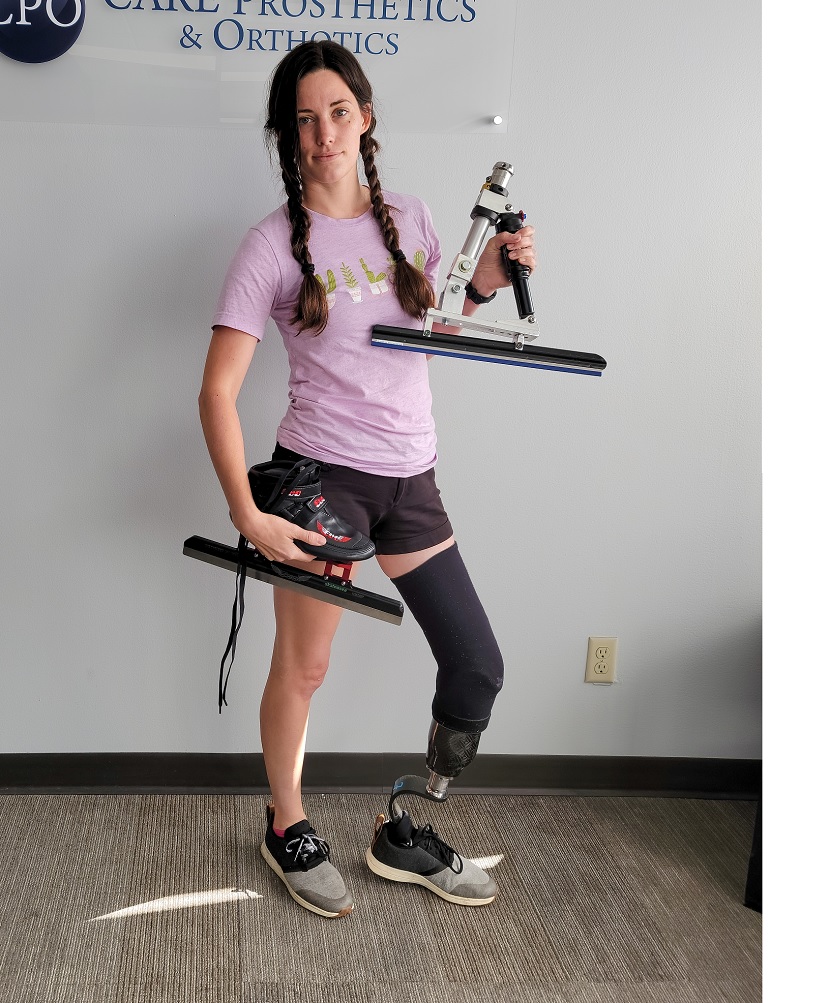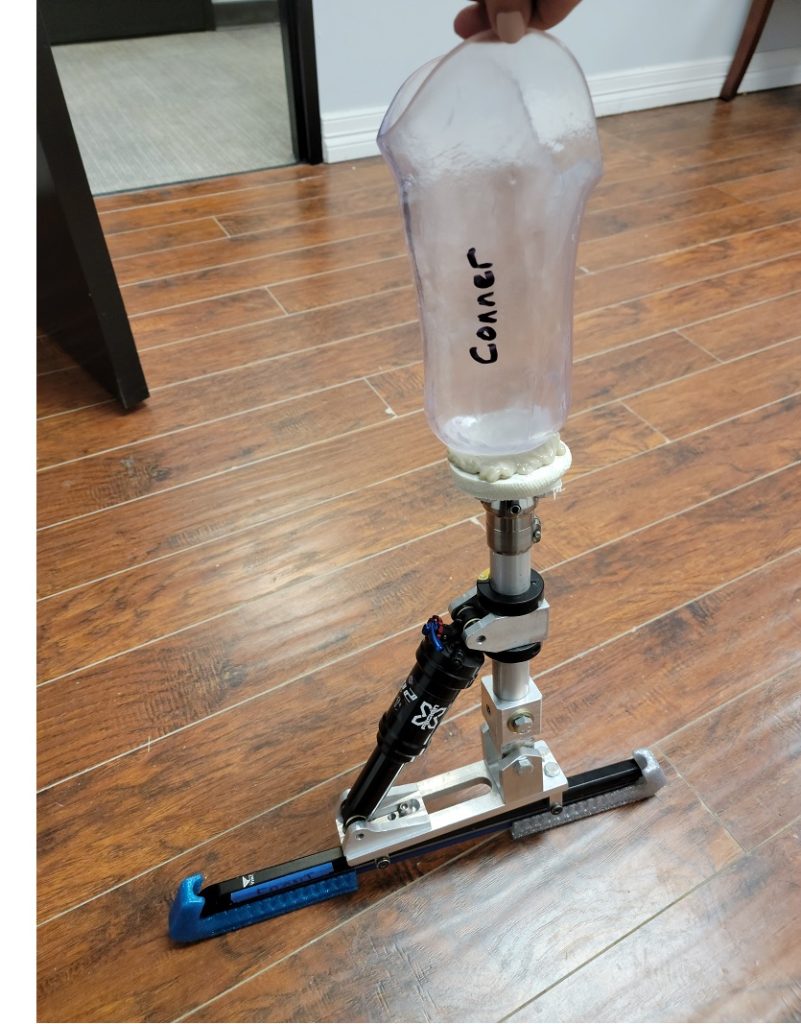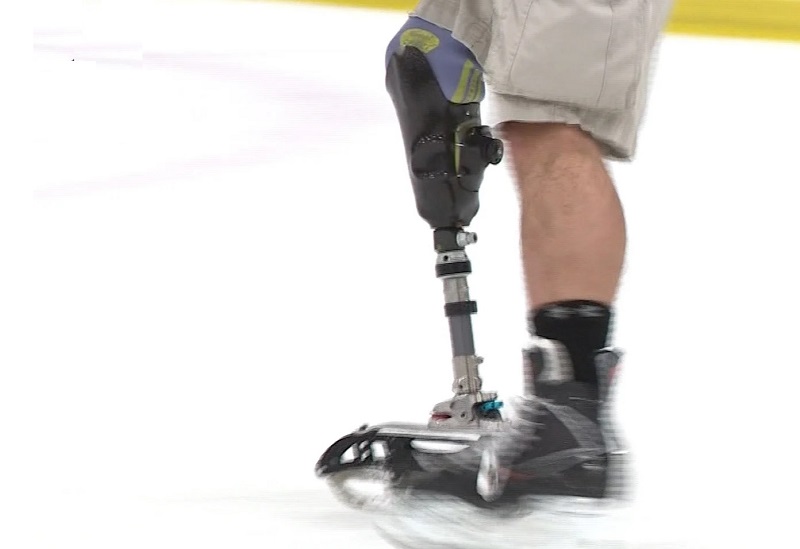
“I think the only reason we don’t have speed skating as a Paralympic sport right now is technology and the fear of falling,” says Caitlin Conner. “But those fears existed with snow sports too, until people experimented and got out there and took the risks and solved the problems.”
As we described in our March/April edition, Conner has been working on the technology side of that equation for almost three years. The onset of COVID slowed things down, but she finally received her first prototype of a prosthesis-friendly speed skate in December. A left BK amputee and founder of Be More Adaptive, Conner is getting ready to hit the ice and put the new skate to the test. Over the long term, she hopes to put speed skating on glide path to gaining approval as the seventh sport in the Winter Paralympics.
We spoke with Conner last month about her passion for speed, her love of experimentation, the challenges of developing a new adaptive sport on a global scale, and the joys and hazards of being first. Our conversation is edited for clarity and length. Follow Conner on Instagram @caitlin.andherlegnamed.rex.
Before you lost your limb, were you an ice skater?
I skated one semester in college for fun. It was a class that I took, just because you had to have so many credits of extracurricular courses. So I learned some of the basics of figure skating and had a general idea of how to do it, but no real professional training.
When you got back into figure skating, was it difficult to relearn how to do that on a prosthesis?
The first couple times, it was actually extremely painful. The first time I could only skate one lap before I was in so much pain that I couldn’t continue skating. It just came down to alignment, because a figure skate has a lift on it—it has about a two-inch heel, so you need to adjust for that. So the second time I used my my high-heel foot, and I got closer. I was able to skate a few laps, but it still wasn’t quite right. I couldn’t bend my knee. Every time I did, I’d fall forward.
After a couple of sessions of trying to do it on my own, I went to my prosthetist and had them align my leg. And as soon as they aligned it, it made all the difference. It was amazing. Then I could go for, like, two hours. My socket wasn’t quite the perfect fit, but I made it work. And I was able to start figuring out stuff. I can spin on my prosthetic leg just fine, as long as I’m spinning in the proper direction. If I spin the other direction, it changes things. It’s just stuff you don’t realize until you start experimenting. And once I started getting some of the technical moves down, I learned very quickly that I could cross over, and I could get low—and that meant I could speed skate. I just needed the right setup.

What does crossing over mean?
The basic move of speed skating is to be able to cross over. A crossover is where you start going into a turn, and you have your inside leg sweeping under your outside leg, and then your outside leg is going over your inside leg. So you’re literally crossing your legs over one another. You’re making an “X” with your legs, basically. And that’s what helps you turn really quickly.
What’s the appeal of speed skating as opposed to figure skating?
I don’t even know the exact moment when speed skating hit my brain. For me, I think it’s just fun to go fast. I’ve done it on a bike, and now I want to do with my own legs—and just my legs. I mean, I’ve got blades underneath, but something about going fast and turning left just sounds great to me. I don’t need a car or a bike to do it. I’m using my body to do it. And to me that’s more interesting.
You really don’t see any paraathletics involving ice. You see sled hockey, but nothing upright—nothing where you have to be ambulatory. And I think that’s a shame. Most of the people I’ve talked to about speed skating, it’s literally their fear of falling on the ice that keeps them from doing it. But even able-bodied athletes in ice sports fall all the time. You just have to learn how to fall properly and not hurt yourself when you fall.
With figure skates, you were able to use regular, able-bodied skates. Why can’t you just use regular speed skates?
The architecture of a speed skate is different from the architecture of a figure skate. Figure skates have toe picks, which no other skates do. Hockey skates don’t, and speed skates don’t. Also, speed skating is more more straightforward, straight-ahead power than figure skating.
But most importantly, when I started experimenting with figure skating, I realized how hard it can be if you have the wrong setup. I made a relatively small change with my figure skates, from a flat foot to one that had a lift, but that told me how important it is to have the right angles and movements. Even with the adjustments I made, there are certain moves I just cannot do on [standard] figure skates.
So fill me in on how you turned adaptive speed skates from idea into reality.
Three years ago I shared this idea with Joel Bach, a friend of mine who teaches engineering from the Colorado School of Mines, and he put me in touch with some students who needed a project. And they were able to take my idea and turn it into a prototype.

The guinea pigs were me and Spencer McGinnis, an amputee who lives in Colorado. We both had some prior knowledge of ice skating—he played hockey before he lost his limb, but he hadn’t ever skated as an amputee. We started running through the motions in our head of what an ankle does. What does it do on the ice? What does it do on the ground? What do our intact ankles do, what do our prosthetics do, and what can they not do? You have to run through that process of what’s the normal movement, versus what we have and what we’re lacking. We had to go through that thought process at the beginning.
Then COVID hit, and the students couldn’t continue the project. So that became an issue. The project got passed to a different set of students a couple of times, and so it took a little bit more time.
How did you work through some of the design challenges to come up with a prototype that would actually be functional?
It was 90 percent Spencer going to the rink and trying things out, because he was there [in Colorado]. I’m here in Texas, and we don’t have anything cold. We don’t have speed skating. So Spencer would spend time at the rink and check each movement. It really took time, and COVID was a big part of that.
When I got the prototype [in December], we had been waiting so long I almost had forgotten what we were working on. It was fun to see how much it changed, but the really fun part was the students sent me a user manual—kind of like IKEA directions. I didn’t read it, of course. I just had to touch it and try to figure it out on my own. I couldn’t wear it anyway, because it didn’t have a socket for it. So I just looked at it, and I was like, “Wait, is this the front end or is that?” And I went through the motions to figure out where the movement is when you’re speed skating—you’re always moving toward the front, never moving backward [as in figure skating]. I could have read that user manual that they went to all the trouble to create for me, but Caitlin doesn’t doesn’t think logically sometimes.
The skate is going to continue changing. Once I get onto the ice and I really start pushing this prototype, we’re going to figure out exactly what needs to be done. I’m gonna have my prosthetic clinic help me, because it’s hard to adjust things on yourself. And the woman I work with used to be a figure skater, so this hits home for her. She knows how to adjust skates, which is going to be great. Because not only do we have to adjust the prosthesis for every movement that it needs, I actually have to get adjusted on my intact side as well, because you have to figure out exactly what part of the blade bears the weight. You have to adjust that on both sides.
What are the next steps?
I will literally have to test this out in a hockey rink, which we have a few of here in Houston, and then fly to Colorado or Utah or anywhere else that has a speed skate track to test this out for real.
Something we’ve done to keep the adjustments minimal is to make sure the skates are the same height, because I need my hips to be even. If my hips are out of whack, the skates are out of whack, and I’m out of whack, and I’m not skating. The line of your body really matters. So we’ve really had to pay attention to that, and the solution is that one skate has a higher blade than the other, which is really interesting. It took me a couple of days to realize that, because I didn’t read that user manual. They’ve done their measurements to make sure the blades and the skates are as even as possible. I need to be as stable as possible, so I can stand and even walk to some degree. You should be able to walk [in your skates] and be balanced. So that is the goal.
When we hit the ice, all the adjustments are going to be based on how low I go. As soon as I start getting lower, into almost a squat position, that completely completely changes my center of balance. The part of the skates that the blade is sitting on is completely adjustable. So once we get to the ice, there’s so many adjustments to be made. So I have to make sure that I’m at least starting from a sound foundation, bring it to the ice, and then keep fine tuning.
Now that you’ve helped build a speed skate from scratch, what’s it going to take to build a Paralympic sport from scratch?
It will take a lot. You need a certain number of countries to be involved, and unfortunately disability is not always accepted all over the world, so we have more people who are able to participate in the US than in some other countries. It has to be a worldwide movement to become a Paralympic sport.
Another thing is that it can’t just be amputees doing it. There are more categories to be considered. You have to consider people with visual impairments, cerebral palsy, spinal injuries, and even people with other limb differences. I’m a below-knee amputee, but an above-knee amputee is gonna have to have a significantly different prosthetic setup. And I don’t know what that is yet.
The Winter Paralympics are pretty limited compared to the Summer Paralympics. There’s just six sports. And speed skating is just a classic kind of sport. It goes back to Hans Christian Andersen and all that, right? It’s very intuitive for people to think about throwing on your skates and seeing who goes fastest. There’s a lot of danger in speed skating. As a spectator sport. it’s some of the coolest stuff.
Part of getting people interested in a new sport is showing people they can do it. The more we’re talking about it, the more we share, the more people want to get involved. So I’m the guinea pig, and I kind of enjoy being the guinea pig. We have to start somewhere, right?



